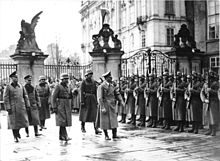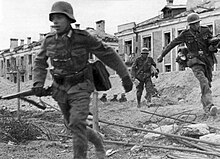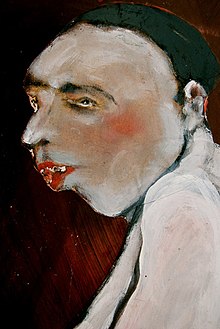Stefan Krikl
Stefan Guido-Maria Krikl , actually Krickl (born January 13, 1936 in Prague , ČSR ), is an American artist of Czechoslovak origin. His expressionist oeuvre includes drawings and paintings as well as photographs , digital prints and book illustrations and is primarily shaped by the artistic engagement with the Second World War in Eastern Europe and the Holocaust . Krikl's miniature installations are special: he created miniature scenarios of war and the Holocaust, for which he used detailed war equipment props and miniature figures. Since the beginning of the 2000s, Krikl has designed several thousand such miniature compositions , which he then photographed and thus staged authentic “ snapshots ”. In some cases he creates artistic digital prints and book illustrations by digitally post-processing selected photos .
Life
Stefan Krikl grew up in Prague as the son of Eduard and Anny Krickl. His father, whose ancestors had been in the military since the 16th century , had also initially embarked on a military career and graduated from the Theresian Military Academy in Vienna ; he had been decorated for his bravery during World War I and had later retired as an officer . Krikl's mother was Jewish and came from a large family, with a total of seven brothers and sisters. Krikl also had an older half-sister who came from his father's first marriage and was already an adult when he was born. Both parents worked as artists. Krikl experienced the effects of National Socialism on his home country as well as the Second World War in his early childhood .

Krikl was three years old when the Nazis called the remainder of Czechoslovakia annexed, the German Wehrmacht in Bohemia invaded and the " Protectorate of Bohemia and Moravia " built. He had to keep the fact that his mother was Jewish and was burdened with a “question of life and death” as a young boy.
“The hardest thing was listening to the children in school, reading postcards from German soldiers bragging. And hearing them talk about the 'low races'. I couldn't believe my mother was what they said. "
“The worst part was listening to the other children at school reading postcards from their boastful German soldier fathers. And to hear them talk about ' inferior races '. I couldn't believe my mother should be 'inferior'. "
Krikl's father tried, with the help of his connections to former comrades from his military service, who had since become National Socialists and served in the German Wehrmacht, to save his Jewish wife from deportation to a concentration camp . Nevertheless, both were arrested in 1943, Krikl's father was sent to a forced labor camp and his mother to a concentration camp. Krikl was taken in by his " Aryan " half-sister. The family was split up; However, all family members survived the rest of the war and found themselves together again in Panama after the war , where they from then on lived in Panama City . Of his mother's Jewish family, only she and two of her brothers survived the Holocaust; a total of 36 family members on his mother's side were murdered in the Nazis' gas chambers .
The family name Krickl , which is difficult to pronounce in Spanish- speaking Panama , was simplified to Krikl , which was then retained. Stefan Krikl finished his school days at the age of twelve and completed an apprenticeship as a jeweler , and later in diamond determination and the diamond trade. On the side he was active as an artist, drawing and painting and had his first exhibition at the Tivoli Gallery in Panama when he was 16. He was promoted by the future art teacher and professor Isaac Benitez.


1952 was a childhood friend of his father and former Nazi, who now also lived in Panama and become "retired German officer" (German during a visit retired German officer before described), two albums with photographs. This former German war veteran took the photos as a hobby photographer during the war and took them with him as “war memories” when he fled abroad. The albums were titled “Our Experiences in the East” and “Postcards from the Front”.
The photographs contained therein, provided with brief explanations, showed "everyday life in war", such as posing soldiers as "conquerors and victor" and "in battle", but also "everyday life in the Holocaust": a church wedding of National Socialists in Krakow Interrogation of a prisoner - a young girl with guards in a concentration camp - an execution . The authentic photos impressed 16-year-old Stefan Krikl very much and "burned themselves into his memory".
“Can you imagine going to Disneyland without a camera to take pictures of all the characters? When the Nazis came, they thought they were taking over for a thousand years. They wanted to take pictures of the natives. "
“Can you imagine visiting Disneyland without taking a camera to take pictures of all the characters? When the Nazis came they thought they would take over the occupied countries for a thousand years. They wanted to take souvenir photos of the natives. "
Krikl later moved to the USA , received US citizenship and worked, among other things, as a jeweler and diamond dealer for Tiffany & Co. Stefan Krikl lives in Fountain Valley in Orange County in the US state of California . He is married and the couple have three children.
Miniature scenarios of war and the Holocaust
In his artistic work, Krikl increasingly dealt thematically with the Second World War in Eastern Europe and the Holocaust, whereby he partly processed his own impressions from his childhood. The photo albums of the former "war photographer" came back to Krikl time and again; the snapshots - with their often grotesque humor, combined with the horrors of war - had an effect on him and increasingly preoccupied him.

Finally, in the mid-1980s, Krikl began - initially more as a hobby - to recreate the photo scenes that he could well remember in the form of lifelike miniature scenarios. From metal and plastic parts of all kinds, which he gathered in second-hand shops and junkyards, he built partly fictitious but realistic military and combat vehicles in miniature size, such as bucket trucks , tanks and artillery pieces . For example, he procured used aluminum baseball bats and used parts of them as conical “gun barrels” for his miniature guns, and in wheeled vehicles he used the wheels of toy cars . The "staff" for his scenarios produced Krikl from commercial GI Joe - Action figures , which he then reworked and redesigned that they accurately as possible correspond to the "real soldiers" and other war participants and -opfern in the photographs in his memory.
Krikl describes his miniature military equipment as "Art-Craft" (German arts and crafts ). With the help of his military equipment props and his figures, he created a total of 26 complete miniature scenarios, of which he then re-enacted the most authentic-looking photos possible. When Krikl began the reconstruction project, he said he had "initially no idea where it would lead him". This resulted in a large number of artistic miniature installations and a long-term photographic project.
Artistic work
Stefan Krikl describes himself as an expressionist artist. He devoted himself to his dominant themes "Second World War in Eastern Europe" and "Holocaust" in the form of expressionist works using artistic techniques such as drawings, collages , digital prints and paintings. Among other things, he created hundreds of expressionist portraits , some of which he described as "unfinished".
This includes series such as Doctors of Death (German doctors of death ), in which Krikl dealt with the concentration camp doctors and other participants in the medical crimes of the Third Reich. For example, several Expressionist portraits of the gynecologist and SS doctor Carl Clauberg , who carried out "sterilization attempts " on female prisoners in the Auschwitz and Ravensbrück concentration camps , and who because of his brutal approach and also because of his small body size, called concentration camp inmates "Die Bestie "(English The beast ) was designated.
In his paintings, Krikl prefers to work with acrylic paints and mixed media .
Alongside his paintings, Krikl's current work consists of his open-ended photographic long-term project, with the two topics Postcards from the Front and Attention, Camera, Action! , which he developed from his earlier miniature scenarios and which he has been working on since around the year 2000. To do this, he forms commercially available action figures, which consist of a plastic compound, by melting them, complements their "facial expressions" with wax , paints the figures and equips them with hair, uniforms , weapons and other miniature-sized pieces of equipment. Then Krikl creates small, realistic-looking scenarios with the prepared figures and with his stock of war equipment props, which he then photographs.
Krikl works with analog and digital recordings and has meanwhile created several thousand staged miniature compositions and "documented" them photographically. In addition, he uses digital image processing to create expressionist digital prints as well as templates for posters and book illustrations that can be assigned to comic art and cartoons . He exhibits his resulting photographs and prints as well as his paintings partly together with some of his miniature installations and his miniature tanks and guns. For example, his solo exhibition Expressionist Cartoons in late 2009 at the communal Central Library and Art Gallery in the southern California city of Huntington Beach consisted primarily of paintings from his newer series Holocaust theater , which curator Gary Sohl replaced with several of Krikl's miniature war implements as props ( German props ) were added.
“His work is a study on the time period of World War II and the atrocities of war. The scenes he creates, or recreates, are his emotional response to what he once viewed and are meant to evoke a similar response in others. "
“His [Krikls] work deals with the period of World War II and the atrocities of war. The scenes he creates or reconstructs are his emotional response to what he has seen and are intended to evoke a similar response in others. "
Krikl has had solo exhibitions, particularly at college locations, as well as in community and university art galleries in several US states, and has been involved in group exhibitions.
gallery
The following two series of images show a selection of Krikl's artistic works:
First series of pictures
In his portrait study Dr. Horst Schumann with volunteer patient (1st picture from left) from the Doctors of Death series , Krikl deals with the SS-Sturmbannführer and “ euthanasia ” killing doctor Horst Schumann , who carried out “ human experiments” in Auschwitz from 1942 to 1944 and who Tried out possibilities of mass sterilization using X-rays. Schumann himself selected his “test subjects” from among the concentration camp prisoners, hardly any of the victims survived. The second picture shows a more recent painting by Krikl from his Holocaust theater series , it represents a dress rehearsal of one of the theater groups of the concentration camp prisoners in the Theresienstadt concentration camp , who performed Hamlet parodies as part of the “cultural activities of this model camp ” .
The following are two examples of Krikl's illustrations , which he created by digitally processing photographs from his project Postcards from the Front or Achtung, Kamera, Aktion! designed. With the comic strip illustration sightseeing and road trips around Auschwitz (dt .: sightseeing and excursions around Auschwitz ) Krikl alludes to the "corporate outings" that the male and female staff of concentration - and extermination camps and the death camps each often undertook together - "For relaxation and to promote morale". The book illustration (4th picture from left) shows an example of Krikl's depictions of a “typical” SS officer (here during the National Socialist military operations in Eastern Europe ), in which he used the “smooth, cold, and smooth type” common in American cinema and television films. evil, intelligent and politically stubborn [...] SS commanders ”interpreted critically.
Second series of pictures The
following is a selection of four photographs from Krikl's project Attention, camera, action! or Postcards from the Front . On the far left a character study of an "SS-Führer-Typus" as a miniature figure by Krikl, which he used in different scenarios and which he used in his series Assassination of Reinhard Heydrich (German: murder of Reinhard Heydrich ) as the SS-Obergruppenführer and Deputy Reich Protector of Bohemia and Moravia , Reinhard Heydrich "used". The second picture (from left) comes from his series Blazing Inferno (Eng. Burning Inferno ) and shows a Wehrmacht soldier with a flamethrower during acts of revenge by the National Socialists after the assassination attempt on Heydrich, such as the destruction of Lidice and Ležáky . The third picture (from left) with the title Shootout at Felsenheim from the series of the same name (Eng. Battle of "Felsenheim" ) shows German soldiers during a fictional battle on the Eastern Front , and the picture on the far right shows one of Krikl's miniature installations the real battle of Stalingrad .
Exhibitions (selection)
Solo exhibitions
- 2009: Expressionist Cartoons - prints, paintings and miniature installations; Central Library and Art Gallery in Huntington Beach , California; Curator : Gary Sohl
- 2007: Postcards from the Front - Photographs; Irvine Fine Arts Center in Irvine , California
- 2005: Postcards from the Front - Photographs; Alkek Library at Texas State University in San Marcos , Texas; Curator: Mary Mikel Stump (as a contribution to the Common Experience program )
- 2004: Postcards from the Front - Photographs; Rogue Community College in Grants Pass , Oregon
- 1991: Recent Works - mixed media; Central Library and Art Gallery in Huntington Beach, California
- 1991: Re-Collections of Selections - 25 expressionist portraits and compositions; College Gallery in Ridgecrest , California; Curator: Prof. Donald Rosenberg (private purchase of the exhibition collection)
- 1990: The Fallen Ones - expressionist portraits, mixed media; Rogue Community College in Grants Pass, Oregon
- 1988: Silent Screams - expressionist paintings and drawings; Ohio State University Art Gallery in Newark , Ohio
- 1987: Reconstructions and Whitewash - selection of 32 expressionist paintings; Norman Feldheym Gallery in San Bernardino , California (purchase of the exhibition collection by the gallery)
- 1985: Doctors of Death - expressionist paintings and drawings from a series of several hundred "unfinished portraits" (dt. Unfinished portraits ), created from 1979 to 1985; Southwest Texas State University in San Marcos, Texas; Curator: Mark Todd
- 1978: Recent Works - expressionist paintings; Winchester Gallery in Santa Ana , California; Curator: Daniel Winchester
- 1976: Terrorists - expressionist portraits, paintings; Pepperdine University in Malibu , California
- 1975: Expressionist Compositions - selection of 35 expressionist paintings presented by Robert Guggenheim; Gallery Lido in Newport Beach , California; Curator: Ruth Jensen
Group exhibitions
- 1984: Guggenheim Gallery at Chapman College in Fullerton , California
- 1984: Brand Library and Art Galleries in Glendale , California (art award; purchase for permanent collection)
- 1983: Newport Harbor Museum of Art in Newport Beach, California
- 1983: Orange County Center of Contemporary Art in Costa Mesa , California
- 1982: Lakeview Museum at Hartman Center in Peoria , Illinois
- 1982: Bradley University in Peoria, Illinois
- 1980: Memphis State University in Memphis , Tennessee
- 1980: Art Center at Columbia College , New York City
Web links
- Homepage of Stefan Krikl (English)
Individual evidence
- ↑ a b c d e f g h Kimberly Edds: Remnants of a Nazi peril on display. The Orange County Register, July 7, 2006, accessed April 3, 2010 .
- ↑ a b FireHouse exhibit evokes images of WWII. (PDF; 69 kB) In: Press release. Rogue Community College, FireHouse Gallery, April 15, 2004, accessed April 3, 2010 .
- ↑ a b 4.2 “Postcards from the Front” and “Attention, Camera, Action!” - by Stefan Krikl. In: interface_08, omar, postmortem_self-portrait. Parsons The New School for Design , Project: Interface_08 , September 30, 2008, archived from the original on January 18, 2015 ; accessed on April 3, 2010 (English).
- ↑ a b Cf. Till Bastian : Terrible Doctors. Medical crimes in the Third Reich . Original edition, 3rd edition, Verlag CH Beck, Munich 2001 (= Beck'sche Reihe; Vol. 1113), ISBN 3-406-44800-3 , pp. 84-87.
- ↑ Cf. Raul Hilberg: Perpetrator, victim, spectator. The extermination of the Jews, 1933–1945 . 4th edition, S. Fischer, Frankfurt am Main 1992, ISBN 3-10-033609-7 , p. 83.
- ↑ See SS doctor Dr. Horst Schumann. Institute for Social and Economic History, University of Linz , accessed on April 3, 2010 .
- ↑ Cf. Eva Šormová: Theater in Theresienstadt . In: Institut Theresienstädter Initiative (Ed.): Theresienstädter Studies and Documents , Issue No. 4/1997, Sefer, Prague 1997, ISBN 3-926893-59-1 , pp. 266–274.
- ↑ See Ernst Klee : "Euthanasia" in the Nazi state. The "destruction of life unworthy of life" . 2nd edition, S. Fischer Verlag, Frankfurt am Main 1983, ISBN 3-10-039303-1 , pp. 160ff.
- ↑ See Lothar Bredella, Wolfgang Gast, Siegfried Quandt: Pictures of Germany on American television. Contents, forms, functions . Gunter Narr Verlag, Tübingen 1994, ISBN 3-8233-4369-6 , p. 20ff.
- ↑ See Günther Deschner : The Heydrich type . In: Sezession (Ed.): Sezession 30, topic: Elite . June 2009, ISSN 1611-5910 , p. 20–23 ( sezession.de [PDF; 229 kB ; accessed on April 3, 2010]).
- ↑ See Hellmut G. Haasis : Death in Prague. The assassination attempt on Reinhard Heydrich . 1st edition, Rowohlt, Reinbek 2002, ISBN 3-498-02965-7 , p. 124ff.
- ^ Postcards from the Front - Stefan Krikl. City of Irvine, California, 2007, accessed October 28, 2018 (exhibit announcement).
| personal data | |
|---|---|
| SURNAME | Krikl, Stefan |
| ALTERNATIVE NAMES | Krickl, Stefan Guido-Maria (real name) |
| BRIEF DESCRIPTION | American artist, exponent of Expressionism |
| DATE OF BIRTH | January 13, 1936 |
| PLACE OF BIRTH | Prague |









